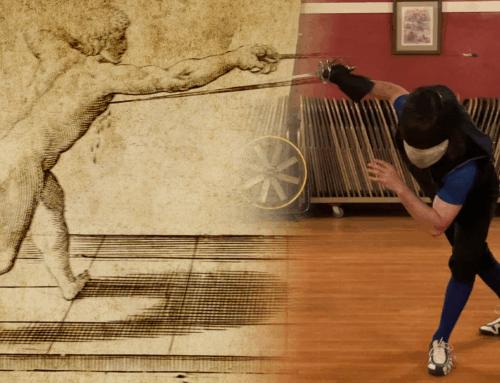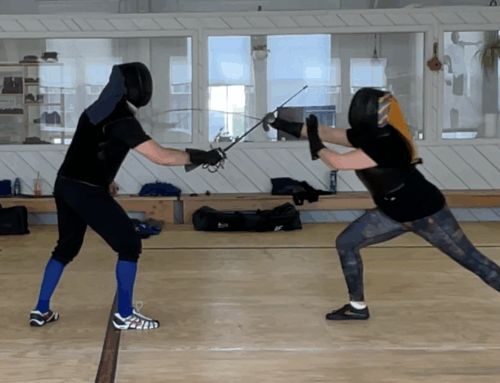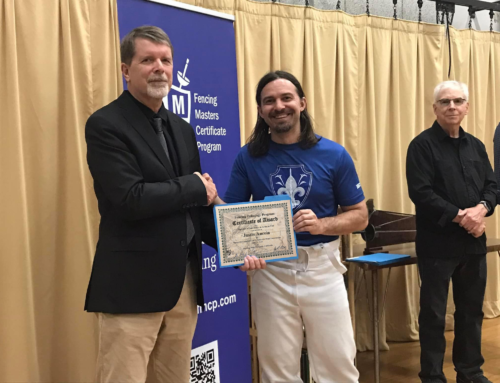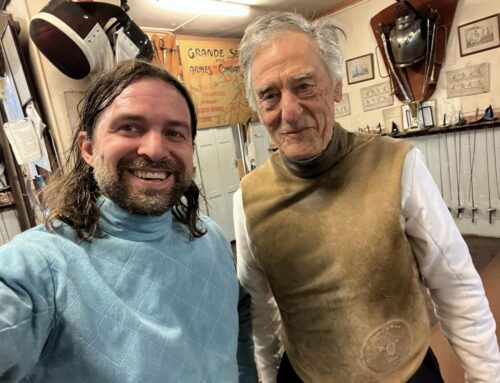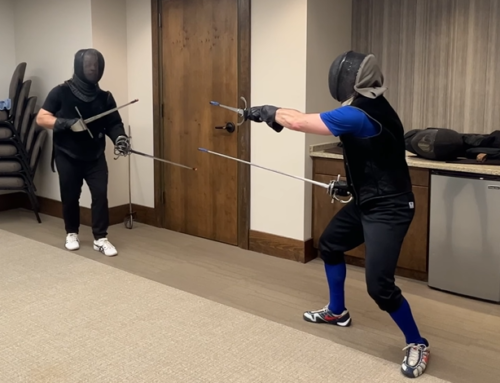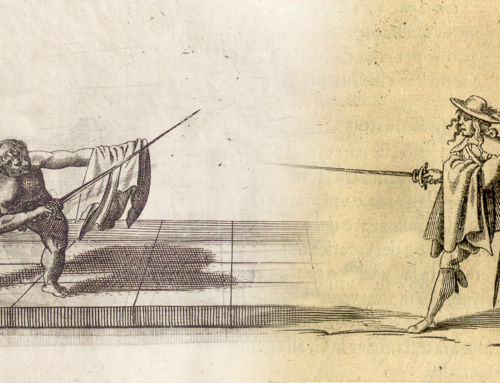This is the second installment of my interpretations of Francesco Alfieri‘s rapier manual. Don’t forget to check out the first post on the stance and the parts of the sword.
I’m hoping to do some video interpretations of Alfieri’s manual once quarantine is lifted; until then, we’ll take a look at the guards and concepts central to his system.
Today we’ll be looking at the first four guards found in Alfieri’s treatise — prima, seconda, terza and quarta. I dive into guardia mista, Alfieri’s fifth guard, in a separate post you can read here.
Of note: I’m using two translations of La Scherma. The first is translated by Piermarco Terminiello et al; the other by Tom Leoni. Both are great translators, but there is significant differences in their translations in a few spots. I did a research paper into it earlier this year. I also think reading multiple translations is a great way to get a better idea of the “spirit” of what a master is trying to communicate.
Don’t read just one book if you can help it.
Overview
For the most part, the primary guards found in Alfieri’s La Scherma fall in line with what we see taught by earlier 17th Century fencing masters such as Giganti and Capoferro. The hand positions are the same and Alfieri shows both leaned back postures as well as forward leaning postures.
The plates in Alfieri’s manual show the “natural” position for each guard, which isn’t “natural” in the sense of how Fabris describes it, but natural as in the common/most comfortable height for the guard. He does mention and describe (albeit lightly) alternative versions of each guard — high and low versions.
This post is covering just the natural positions. If there’s interest, I can attempt to interpret the high and low positions of each guard, too. They’re typically used as counterguards, but Alfieri pins a few of them with other European cultures (high terza favored by Spain, low terza favored by the French, etc.).
Prima

Prima is the first guard and “precedes all others, in order and by nature.” It’s named after “the position of the hand drawing the sword…” There is a high version (demonstrated in this post) and a low version.
Prima is good for protecting the head on the high outside line and angling downward thrusts which can be difficult to parry. It is more easily countered with a high terza dominating the debole which is in a very weak position while in prima.
Position
- Arm is extended & above the head
- Illustration shows arm bent and arm retracted a bit, however (see note further below)
- True edge faces up
- Alfieri: True edge up
- Point closer to opponent and aimed at the opponent’s eye
- Moderate step/stance
- So not as wide as in terza, for example.
- Body isn’t too straight or too bent over
- Illustration shows a moderate hinge forward over the lead hip & the body a bit more square
- Weight over the left knee
- Off-hand kept above the shoulder or “held free and nimble”
Pros
- Good for receiving cuts
- Your body’s target is further away from the opponent
Cons
- Guard is tiring and makes fighting in it difficult for long
- Hard to defend in this guard; need to break measure or use off-hand
- Sword isn’t equidistant from the parts of the body it needs to defend
- Easily put into obedience
Openings:
- High line
- Around the front knee (low line)
I’ll note that the illustration shows prima with a more bent sword-arm in line with the fencer’s ear. However, Alfieri explicitly says prima is formed with the arm extended and the sword point closer to the opponent, so I’ve gone with the text version for my main interpretation.
However, the plate image is more akin to Fabris’s prima after drawing the sword (Fabris Plate 1), but Alfieri’s description of prima is like Fabris’s “properly formed” prima (Fabris Plate 2). Here’s my interpretation of the plate version of Alfieri’s prima for comparsion.
Prima isn’t a major player in Alfieri’s plates, but it’s plausible that he used both.
Seconda

If we lower our arm to shoulder height and rotate the hand so the palm faces down, we are in seconda. The arm should be in a straight line from shoulder to sword-point. The rest of the body is held like in prima.
Seconda is primarily used to strike/cover the high outside line and leaves an opening to the inside line.
Position
- Arm is extended & in a straight line with the shoulder
- True edge facing to the outside line
- Alfieri: True flat up
- Point closer to opponent & aimed at opponent’s eye
- Moderate step/stance
- Weight over the left knee
- Body isn’t too straight or too bent over
- Illustration shows a moderate hip hinge forward and a smidge squared-up.
- Off-hand is kept above the left shoulder or “held nimble and free”
Pros
- Good at receiving cuts
- Body target is further away from opponent
Cons
- Guard is tiring and makes fighting in it difficult for long
- Hard to defend in this guard; need to break measure or use off-hand
- Sword isn’t equidistant from the parts of the body it needs to defend
- Easily put into obedience
Openings:
- High line
- Around the front knee (low line)
Terza

If we lower our arm some more and rotate the hand inward we’ll arrive into terza. This guard is held to the outside of your knee and with the point angled slightly to your outside line. The guard protects and is used to strike on the outside line. It’s opening is to the inside line. It has a high and low version (the “natural” version is shown here).
Position
- Well-balanced in posture — neither too high nor too low
- Illustration shows the body leaned back
- Weight is rested over the left leg
- Arm is extended
- Line of the sword arm & sword covers the flank
- Sword hand is outside the front knee
- Hand is not turned inside or outside, but giustezza (natural position)
- True edge faces down
- Alfieri: False edge up
- Illustration shows the off-hand held back by left shoulder
Pros
- Can find/gain opponent’s sword high or low
- Easier to disorient your opponent
- Easier to throw feints
- Easier to perform cavaziones than seconda or prima
- Attacking is quick — both cust & thrusts
- Parries are quick
- Parry to the outside in terza and strike in terza
Cons
- Opponent can easily find/gain & close the line with the correct counterguard (contraguardia)
- A counterguard is a way of thwarting & dominating your opponent’s blade
- Easy to beat to the tempo & into measure in all lines, creating an open centerline
- This happens when the hand in terza is formed too low.
- This makes the point high and creates an angle at the hand
- Slow and far to defend targets of the body
- “Useless” for the cavazione
- This happens when the hand in terza is formed too low.
An extended terza is better than an angled terza. This forces the opponent to move out of line.
Note: Alfieri’s terza doesn’t seem to be like the “properly formed terza” found in Fabris and Vienna Anonymous, but more like the “terza to the outside of the knee” used for stringering on the outside line, as found in Capoferro and interpreted by Guy Windsor as well as David & Dori Coblentz’s Intro to Italian Rapier.
This will matter more when trying to differentiate Alfieri’s terza to his guardia mista.
Quarta
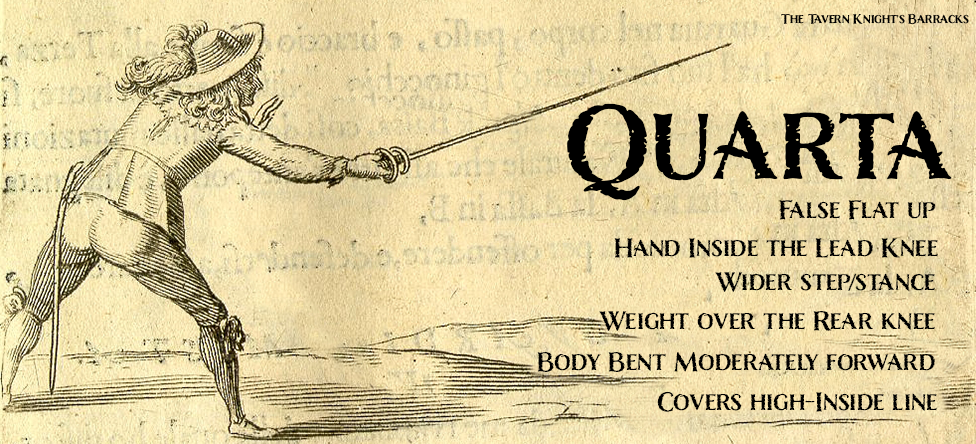
From terza if we rotate our hand some more so the palm faces up and we move the hand to the inside of the knee, we are in quarta. This guard is used to cover and strike on the inside line and has a high & low version (the “natural” version is shown here).
Position
- Well-balanced in posture — neither too high nor too low
- Illustration shows the body hinged slightly forward over the lead hip
- Weight is rested over the rear leg
- Sword hand is inside the front knee
- Arm is extended
- True edge faces the inside line
- Alfieri: False flat up
- Illustration shows the off-hand held slightly forward of the face
Pros
- Can find/gain opponent’s sword inside
- Easier to disorient your opponent
- Easier to throw feints
- Easier to perform cavaziones
- Alfieri likes quarta best for cavaziones
- Attacking is quick — both cust & thrusts
- Parries are quick
- Parry to the inside in quarta and strike in quarta
- Comfortable for striking, defending, waiting, or attacking
Cons
- Opponent can easily find/gain & close the line with the correct counterguard (contraguardia)
- Easy to beat to the tempo & into measure in all lines, creating an open centerline
- This happens when quarta is created with an angle in the hand and point high.
- Fencer thinks they’re fortifying their guard by doing this, but they’re creating weakness
- This happens when quarta is created with an angle in the hand and point high.
An extended quarta is better than an angled quarta. It forces the opponent to move out of line.
Openings:
- Outside line
What About Guardia Mista?

Given the level of celebrity of Alfieri’s guardia mista, the varying interpretations of it, and the importance Alfieri places on his “invented” guard, I wanted to give guardia mista it’s own blog post to shine. You can check it out here.
DONATE: If you liked this blog post and my other content, please consider donating to the cause so I can pay bills and continue to be able to conduct historical martial arts research. https://www.paypal.me/thetavernknight


















